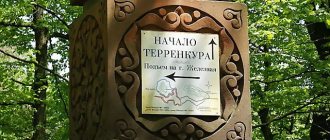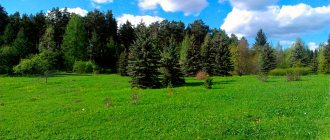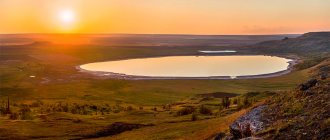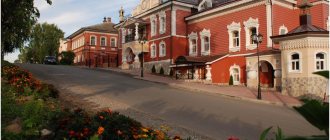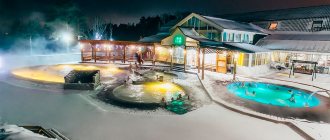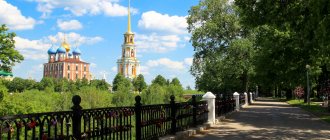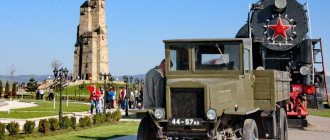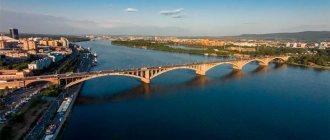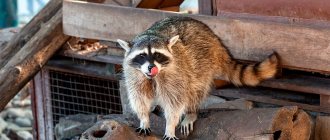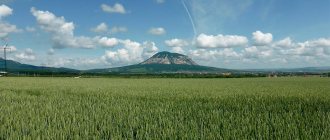Story
Bakhchisaray was founded at the beginning of the 16th century. Although settlements in its vicinity existed even earlier. Thus, during the time of the Golden Horde, not far from modern Bakhchisarai there was a cave city of Kyrk-Er (now Chufut-Kale), and at its foot was the settlement of Salachik. It was Salachik that was chosen by the Crimean khans as the first capital of their state.
Khan's Palace
In 1503, Khan Sahib I Giray founded a new residence and called it Bakhchisarai (translated from Tatar as “palace garden”), around which the new capital grew. By the 17th century, Bakhchisarai had become one of the largest cities in Crimea.
In 1736, the capital of the Crimean Khanate was burned by Russian troops. After the annexation of Crimea to Russia, Bakhchisarai remained an important trading center of the peninsula until the end of the 19th century. Then its value began to fall. Modern Bakhchisaray is a provincial city with a rich history, which is the center of Crimean Tatar culture.
Population of Bakhchisarai
According to the latest statistics, the city's population is 27 thousand people.
If we consider which nationality is more represented in quantitative terms, we get the following picture:
- 49% Russians;
- 25% Crimean Tatars;
- 23% Ukrainians;
- 3% - other nationalities: Jews, Karaites, Belarusians, Germans, Greeks, Bulgarians, Armenians, Chechens, Moldovans, Gypsies, etc.
City population at the festival
After the collapse of the USSR, the demographic situation left much to be desired. If anyone has not slowed down the birth rate, despite the crisis and the almost complete lack of cash payments, it is the Crimean Tatars. Their task was to fill Crimea with representatives of their nationality as quickly as possible after returning from deportation. As can be seen from the statistics, they succeeded.
As for the jump in the birth rate in the last 2-3 years, this is largely due to the laws adopted by the Ukrainian government. Payments for the birth of children were increased. The benefit for the 3rd child is $11,538, spread over 6 years. A family with 3 children was considered to have many children. Benefits: 50% payment for utilities, first in line for free trips to sanatoriums, free travel on public transport. State reforms to provide for families with children had a positive tendency to increase the birth rate.
If we talk about migration processes, then in Bakhchisarai, due to certain difficulties in getting a job, many men and women of working age leave for Russia, Europe and Turkey. Crimean Tatars are looking for employment options in Turkey. The work is no different from that of the Slavs in Europe: caring for children and elderly people with disabilities. Therefore, a significant part of the working-age population is outside the city, and the majority of residents are pensioners and young mothers with children.
People of retirement age who previously lived in Simferopol, Sevastopol and the northern regions of Russia are buying apartments and houses in Bakhchisarai, as the city is quiet and peaceful.
Over the past ten years, a friendly atmosphere has developed in the multinational region.
Food
Bakhchisaray is famous for its traditional cuisine. Popular dishes of Crimean Tatar cuisine:
- Chebureks and yantyki with cheese or meat
- Pilaf, shish kebab, lagman (thick soup with meat) and manti (similar to large dumplings)
- Khash - meat soup
- Yufkhash - tiny dumplings
- Bakla shorbasy - lamb soup with beans
- Silkme - usually lamb with vegetables
- Samsa in tandoor with meat and kubete (meat pie)
- Sweets: baklava, sherbet, Turkish delight
City-forming enterprises and work in Bakhchisarai
Judging by the information provided on Wikipedia about the enterprises of Bakhchisarai, everything is not bad. In fact, the situation is much worse. The agricultural processing industry was well developed. During the years of independence, all equipment within Ukraine was destroyed, sawed up and removed. The following ceased to exist: a dairy plant (now there is a store selling Chinese consumer goods in the workshop), a cannery, a plant for processing essential oil crops, a juice extract plant, a sausage shop, and a wool spinning factory.
3 companies left:
1. PJSC Bakhchisaray Plant Stroyindustriya is the only enterprise producing cement on the Crimean peninsula. The location of lime marl and other components for production is 1.5 km from the plant. More than a thousand people work here. In the morning the bus takes people to work, and in the evening it takes them back around the city. Employees are provided with medical care directly at the enterprise.
PJSC "Bakhchisarai plant "Stroyindustry"
Whatever they say, people are exposed to harmful chemicals that settle in the lungs and develop occupational diseases - silicosis. The fate of the enterprise itself is not very prosperous; each new Kiev government bought up the plant. Naturally, this had a negative impact on wages in the direction of their reduction. And even now the average hard worker cannot boast of millions. The average salary is 200 dollars. Although we must pay tribute to the plant: it owns two recreation centers on the seashore in the village. Uglovoy and Peschanom, where employees and their families can go on vacation, but also not for free. Pensioners are paid small dividends for the holidays
2. PJSC “Crimean Wine and Cognac. Its fate is similar to that of the Stroyindustry plant: new owners constantly appeared, and many of the subtleties of production were lost. If earlier you could say with confidence that you were buying quality wine, now you have to look for it; powder wines have replaced it. The number of employees is about 200 people, the average salary is around the same 200 dollars. One of the places for selling and tasting wines is located near Khansky. Here you can taste the wines of the Bakhchisarai winery and purchase products. Wine prices are affordable. Among the popular brands: sparkling “Bakhchisarai Fountain” (on the label there is a fountain of tears with Pushkin’s roses), Eski-Kermen wine, Crimean muscat, Khan’s Palace wine, Crimean white port, Kachi-Kalen wine, Janike wine. Grapes for wine production are grown in the Bakhchisarai region.
3. CJSC “Bakhchisarai Bakery” in the old days was famous for its bagels and dry breads. At the moment, there are 146 officially employed employees, the practice is to work without registration and pay after the shift. They bake social bread, sweet buns, pastries, pies, and cookies.
Residents of the city mainly work in Simferopol, Sevastopol or are engaged in resale on the market. There are 4 markets in Bakhchisaray. Most salespeople are not officially employed, but receive salaries in envelopes. Working in the city is difficult. The holiday season saves us a little: some people go to work by the sea, others get a job for the summer season as a tour guide in the city or in Crimea.
At the same time, pharmacies and banks are growing by leaps and bounds in the city. The pharmacies are owned by the daughters of local authorities and are built in places where they find it convenient. Those who disagree and are indignant are framed and fired from their jobs.
Pharmacy of the daughter of the chairman of the Bakhchisaray district council on the territory of the BTsRB clinic
Attractions
Khan's Palace
Khan's Palace.
Palace Square Khan's Palace is the most important attraction of Bakhchisarai and a unique monument of Crimean Tatar architecture. The construction of the palace began in the first half of the 16th century. In 1736 (after the capital of the Crimean Khanate was burned by Russian troops), the palace was restored by architects from Istanbul. The modern appearance is the result of historical reconstruction carried out in the second half of the 20th century. Currently, the Khan's Palace is also undergoing large-scale reconstruction.
During the heyday of the Crimean Khanate, the palace occupied an area of 18 hectares and was surrounded by greenery. In its gardens and shady courtyards, numerous fountains gurgled and beautiful flowers bloomed. Currently the palace has an area of about 4 hectares.
The facade of the palace is painted with fancy ornaments. Now the main entrance to the palace is the Northern Gate (one of the two surviving palace gates), which leads to Palace Square. They are made in the shape of an arch, over which a small watchtower is built. The Suite building is adjacent to the gate on the left. The gate and tower date from the first half of the 17th century.
Great Mosque
Palace Square was the center of this architectural ensemble. Most of its iconic attractions are located along its perimeter. During the time of the Crimean Khans, the square was covered with sand and was usually used for ceremonies and formation of troops. Now this space is paved with stone and diluted with plants.
One of the architectural dominants of Palace Square is the Great Khan Mosque, located east of the Northern Gate. This building was built in 1532 by Khan Sahib I and is one of the largest Muslim buildings in Crimea.
The mosque is also one of the most beautiful buildings of the Khan's Palace. Its walls are decorated with ceramics, and its architecture features two 28-meter minarets. The interior space is formed by a hall with columns. There is also a mihrab and Khan's lodge here. Interestingly, the main entrance to the mosque was from the Churuk-Su River.
Bathhouse Sary-Gyuzel
The Sary-Gyuzel Bath is one of the oldest structures of the Khan's Palace, dating back to 1532 and located east of the Great Mosque. The bath complex was built and planned in traditional Turkish style.
Khan's cemetery. Durbe
To the south of the mosque is the Khan's cemetery, founded in the early 16th century. About a hundred ancient tombstones have been preserved here and nine khans from the Giray clan are buried.
In the far corner of the gardens is the Dilyary-bikech durbe - the mausoleum of the beloved wife of one of the Crimean khans, built in the second half of the 18th century. The Fountain of Tears was originally installed here. Durbe is an octagonal structure with a lead dome.
Demir-Kapı
Demir Kapi is the old main entrance for ambassadors and the oldest surviving part of the Khan's Palace. The portal was built in 1503-1504. in Venetian style and decorated with numerous decorative elements.
Falcon Tower
The Falcon Tower is a two-story structure south of the harem, built in the second half of the 18th century. Once upon a time, birds of prey were kept here. The tower has a height of 15 meters. The upper tier has a hexagon shape and is made of wood.
"Fountain of Tears"
“The Fountain of Tears” is the most famous fountain of the Khan’s Palace, glorified by Alexander Sergeevich Pushkin in the poem “The Bakhchisarai Fountain”. It was made by an Iranian master in 1764. Initially, the fountain was located near the Dilyara dyurbe, and then was moved to the Fountain Courtyard. In its center, a flower is carved from marble, from which drops flow into the bowl, resembling tears. This is a symbol of the Khan’s eternal grief for his beloved wife.
Golden fountain
The Golden Fountain is another famous fountain of the palace, located at the entrance to the Small Khan Mosque and decorated with beautiful golden ornaments. It was created in 1733 from marble and was used for ablutions.
Summer gazebo
Other interesting buildings of the Khan's Palace:
- Harem. Once upon a time it was an entire ensemble of four buildings, which included more than 70 rooms. By the 19th century, the buildings had become so dilapidated that it was decided to demolish them. A small outbuilding and a gazebo have survived to this day.
- Summer gazebo. Intended for recreation, it was open and had one floor. In the 19th century, the Golden Cabinet was built on and stained glass windows were installed.
- Divan Hall. This is the center of power of the Crimean Khanate, a hall intended for state meetings. In the center of the southern wall stood the throne of the khan, to the left and right of which there were sofas for his immediate circle. Along the walls, noble beys sat on benches. This room is one of the most beautiful in the Khan's Palace.
- Small Khan Mosque. Used for prayers by khans and their relatives. The mosque was built in the 16th century.
Other sights of Bakhchisarai
Ismi Khan Jami
Ismi Khan Jami is a small ancient mosque in Bakhchisarai, built between the 16th and 17th centuries with donations from the khan’s niece.
Orta-Jami
Orta-Jami is one of the main mosques of Bakhchisarai, built in the second half of the 17th century. Located near the Khan's Palace.
On Ismail Gasprinsky Street there is another ancient Takhtali-Jami mosque, built in the early 18th century.
Chufut-Kale
Chufut-Kale is a medieval town located 3 km from Bakhchisarai on a rocky base. Known under the name Kyrk-Er, under which it was first mentioned in 1254.
It is believed that the settlement here was founded in the 5th - 6th century during the Byzantine Empire. In the Middle Ages, there was a city called Kyrk-Or, which was controlled by the Golden Horde and was the center of the principality of the same name. During the heyday of the Crimean Khanate, the city was considered one of its most powerful fortresses. Kirk-Or was abandoned in the 19th century. Fragments of walls and gates, ruins of mosques, mausoleums and old houses have been preserved here to this day.
Assumption Anastasievsky Monastery
The Assumption Anastasievsky Monastery is an ancient cave monastery, presumably founded in the 6th or 7th centuries. Located near Bakhchisarai in the Mariam-Dere gorge. The Assumption Monastery is one of the religious centers of Crimea and includes as many as five churches.
Syuren Fortress
The Syuren Fortress is an ancient structure dating back to Byzantium. The ruins of the wall, fragments of the main gate and a powerful 13-meter defensive tower have survived to this day.
Eski-Kermen
Eski-Kermen is another ancient cave fortress city, second in popularity after Chufut-Kale. It was built in the 6th century as a Byzantine fortification on a rocky plateau. During its heyday, Eski-Kermen was home to several thousand inhabitants. To this day, cave temples with fragments of frescoes and several hundred caves used for residential and economic needs have been preserved here.
Kachi-Kalyon
Kachi-Kalyon is a cave city that existed from the 6th to the 18th centuries. Built on a massive rock.
Tepe-Kerman
Tepe Kermen is a cave city founded by the Byzantines in the 6th century. It existed for eight centuries, reaching its peak in the 12th century. Built on the slopes of a 544-meter mountain and has several levels.
City infrastructure
In addition to the railway connection, the city has a bus station, from where buses depart throughout Crimea and to nearby cities of continental Ukraine: Dnepropetrovsk, Kherson, Melitopol, Nikolaev, Odessa. The Bakhchisaray district unites towns and villages that are located on the Black Sea coast: Peschanoye village, village. Angular, s. Beregovoe. You can get to the sea either by personal transport or by buses and minibuses. Time from 30 to 60 minutes. The distance is approximately 15-20 km.
Utility companies in the city operate in working mode and ensure timely supply of water, gas, and electrical energy. Prices are regulated at the level of deputies sessionally.
Residents, in order not to overpay for services, install meters for water and gas. The inadequate price during the heating season of about $100 for a 3-room apartment is solved by providing an individual heating system in the apartment, then the cost of gas according to the meter will be about $20-30 per month.
A family of 4 pays about $100 for all utilities in the winter, with individual heating and all meters without strict savings.
An enterprise that practically does not provide quality services in the city is the housing office. Yes, street cleaners clean the courtyards, but the entrances remain the responsibility of the local residents. Cleaning up courtyards and arranging children's playgrounds also falls on initiative groups of concerned residents. Those who want to make sandboxes, swings and benches for children take care of their children themselves. Roofs in houses are leaking, sewerage is leaking, and the housing office responds to letters from residents with unsubscribes rescheduling repairs.
City. View from above. Photo by Oleg (https://fotki.yandex.ru/users/olegcustom/)
Food prices largely depend on the harvest. It happens that you can go out into the courtyard of a high-rise building and pick cherries, cherries, apricots, walnuts, peaches, apples for compotes, jam, for freezing.
For example, food prices: a 50 kg bag of sugar - about 40-50 dollars, flour - 15-20 dollars.
The condition of the roads leaves much to be desired. Minor patching of sections of the road does not solve the problem as a whole. True, there are no traffic jams in the city. From public transport: buses, minibuses and taxi services. At night, minibuses do not run; you have to use a taxi service.
The number of kindergartens does not cover the needs of city residents. Schools cope with the load, but in the lower grades there is a system of two shifts.
There are no higher educational institutions. Only the middle level: construction college and vocational school, teaching construction specialties.
Cultural life: 2 libraries that hold competitions, writers’ evenings; The House of Culture hosts touring artists.
Where to stay for vacation?
Tourists who have given their preference to the Crimean peninsula are attracted to holidays in Bakhchisarai by its beauty, but there will be no problems with accommodation here. Numerous hotels and the private sector will offer their services, where you can rent housing without intermediaries at a competitive price.
Hotel "Bakhitgul", located in the central part of the city, is always happy to receive
guests, providing them with their comfortable rooms, which are equipped with everything necessary for their stay. Meals for guests are provided in a small home restaurant. There is also a cafe and a hookah courtyard. There is a swimming pool on the territory of the Bakhchisarai hotel. You can book a horseback ride around the area.
You can choose a cheaper accommodation option by staying at the Meraba guest house. All rooms, the interior of which is made in light colors, are equipped with climate control systems and equipped with household appliances. The kitchenette, equipped with everything necessary for a comfortable stay, allows you to eat yourself. You can even come here with pets.
At the small Efsane Hotel, all rooms have air conditioning, and some have kitchens. You can order breakfast delivered to your room. The atmosphere in the establishment is almost family-like, and the service is great. Here you can rent a bicycle and take a recreational walk around the city of Bakhchisaray. A holiday in Crimea here will definitely be successful!
Miniature Park
The Crimean Miniature Park occupies an area of 2.5 hectares, where you can see all the main historical objects of Crimea. It is one of the main attractions of Bakhchisarai. At the park site there are copies of temples, historical monuments, palaces, on a miniature scale of 1:25. This is the largest exhibition exposition in Crimea, where the sights of Yalta, Yevpatoria, Feodosia, Sudak, Gaspra and other coastal cities of the peninsula are collected. The Museum of Crimean Miniatures is an ideal place to visit if you don’t have time to visit all the tourist spots. Here are copies of the Livadia Palace, the Swallow's Nest, the Vorontsov Palace, Massandra, the Fog Bell of Kherson, and the Lighthouse Temple of St. Nicholas of Marliki. In the evening, additional illumination of all exposures is turned on.
FAQ
can you go with children in Bakhchisarai Fountain of Tears in Bakhchisaray, Bakhchisaray Miniature Park, Sphinxes of Churuk-Su,
What can you see in Bakhchisarai for free? Catherine's Mile, Ismi Khan Jami Mosque, Church of the Theodore Icon of the Mother of God, Eski-Dyurbe Tomb, Takhtali-Jami Mosque
4 main attractions of Bakhchisar that are definitely worth a visit? Khan's Palace, Lariches Historical Museum,
Assumption Monastery
Of course, we also visited the Assumption Monastery, the history of which is very interesting. According to legend, one shepherd drove his sheep to pasture into the Assumption ravine, and saw an icon of the Mother of God on a rock and a burning candle in front of it. What he saw shocked the shepherd, and he immediately informed his master about it. The icon was taken from the cliff and hung at home. However, in the morning, the icon stood in its original place. This happened several times. And then everyone realized that the Mother of God wanted to be in exactly that place. This is how the small temple arose. Over time, the territory of the monastery grew. During the war years there was a hospital there, then the monastery was closed. Since 1993, the monastery has been active, so when visiting this shrine, do not forget to dress appropriately.
Assumption Monastery
In the Assumption Monastery
How to get there
It’s easy to get to Bakhchisarai from any city in Crimea:
- a bus departs from Simferopol from the Zapadnaya bus station every half hour, travel time is 30 minutes;
- from Sevastopol from the bus station, regular buses depart every 20 minutes, travel time is 40 minutes;
- There are also regular buses from Yalta to Bakhchisarai in Crimea, but you will have to spend more time - 3 hours; it will only be faster by private car through Ai-Petri.
If you want to get to Bakhchisarai from mainland Russia by car, then after crossing the Crimean Bridge you just need to drive, without turning, along the Tavrida highway, and after 270 km (a little more than 3 hours of travel) you will be there.
We hope that our article helped you understand where Bakhchisarai is located in Crimea, what you can see here and how to get here. Bakhchisarai is not a popular resort like Yalta or Yevpatoria, but this is its charm. Due to the short distance from the sea, there are few tourists here, which allows you to fully enjoy the indescribable atmosphere and charm of this “garden-palace”. You can safely stay here for a few days in order to have time to explore the city itself and its surroundings without haste, or you can go on an excursion to Bakhchisarai from neighboring cities. If you wish, you can even combine a visit to Bakhchisarai with a beach holiday, especially if you have a car and don’t mind spending about 20 minutes on the road to the sea. In any case, you definitely need to see this city, where else can you find such an amazing Crimean Tatar flavor.
0 0 votes
Article rating
Criminal situation
About Bakhchisarai you can say the good old proverb “The fish rots from the head.” Petty thieves are foolish children compared to the city leadership. The level of bribery exceeds all possible limits. The system is built in such a way that you pay at all stages: when you cross the threshold of the clinic, you pay for tests, for visiting a doctor. The same situation is with kindergartens and schools. In order to enroll a child in kindergarten, you need to pay 600 - 700 dollars, not counting the constant fees for repairs, cleaning supplies, etc.
At the clinic, the director gathers doctors and says who should collect how much for a month of charity... At the same time, no one is interested in how the doctor will talk about money to the patient (doctors are also different), and if you don’t take it from people, then you have to give it from your salary, and she is small. Charity money in a minimum amount is passed through the bank's cash desk.
The level of corruption is catastrophic.
Apart from petty thefts, there were no major crimes in the city.
Cultural centers
Bakhchisaray District House of Culture (1964). Crimean Tatar cultural and educational ethnographic center (1992). On the basis of the Municipal Cultural Institution “Centralized Club System of the Bakhchisaray District”, Crimean Tatar ensembles operate in the city - choreographic “Ilham” (founded in 1998, since 2003 folk group), vocal “Ebediet” (founded in 2004, since 2007 folk group) and etc.
International Crimean Tatar festival “Bakhchisarai” (since 2008).
Park "Crimea in Miniature" (2013).
Fountain of Tears
You can get from Simferopol to Bakhchisarai by bus, train or taxi. To see the fountain, you need to transfer to public transport or use your navigator to enter the street address. Rechnaya, no. 133.
The architect who worked on the creation of the fountain was the famous Iranian architect of his time, Omer. The fountain was conceived as a reminder of the grief of Khan Crimea-Girey for his beloved concubine. She was a girl from Poland, a person of noble origin, Maria Pototskaya, named Dilyar Bikech in the harem. She was killed by an envious woman.
The marble slab reflects the emotional pain of loss, the water slowly flowing down the stone represents the stingy tears of a man. The snail carved on the structure represents the khan’s doubts about whether it is worth living without his beloved among friends, enemies and ill-wishers.
Climate
The climate of Bakhchisarai in Crimea is continental - winters are mild, summers are hot. The weather in this area is changeable; winds often blow during the day, but in the morning and evening, on the contrary, it is calm. The flows of mountain and steppe air intersecting on the territory of Bakhchisarai in Crimea create a concentrate of coniferous phytoncides and evaporation of essential oils of steppe herbs, which gives the local air a powerful healing effect.
